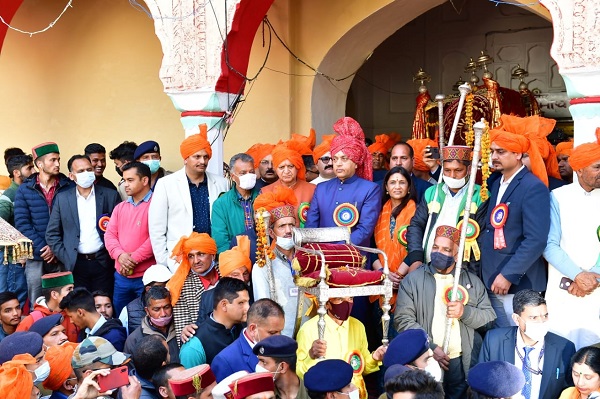Mandi, (Asian independent) Himachal Pradesh Chief Minister Jai Ram Thakur on Wednesday inaugurated the weeklong Maha Shivratri celebrations in Mandi with religious fervour.
The centuries-old festival is celebrated with a difference in Mandi, popularly known as Chhoti Kashi, as it sees the congregation of over 216 hill “gods and goddesses”. The Mahashivratri festivities ended in other northern states on Tuesday.
The Chief Minister announced 33 per cent increase in “Nazarana” or honorarium of deities and 100 per cent hike in “Bajantris”.
Earlier, the Chief Minister, after paying obeisance at the temple of famous and principal deity Raj Madhav Rai, participated in the traditional “Jaleb” or procession that started from the Raj Madhav Rai temple and culminated at the Paddal ground.
Thousands of people dressed in their traditional dresses participated in the procession carrying their local deities and dancing all the way up to the Paddal ground.
Like the week-long Kullu Dussehra festivities, Mandi’s Maha Shivratri also sees a congregation, in which there are both divine and temporal aspects.
The tradition of celebrating Maha Shivratri began in 1526 when the town was founded during the rule of Ajbar Sen.
He “invited” all local deities to mark the founding of the new town.
During the first day of the festival, Lord Madho Rai, an incarnation of Lord Vishnu and the chief deity, leads the procession.
The assembled deities follow him in beautifully decorated palanquins, as per protocol, amid beating of drums and playing of “shehnais” and assemble at the Bhutnath temple here.
Three such processions, locally called “Jaleb”, would be taken out on the opening, middle and concluding days of the festival, organisers said.
Mandi, located on the Chandigarh-Manali national highway-21, is dotted with more than 80 temples built in typical hill architecture.
The prominent temples are those of Bhutnath, Triloki Nath, Jagannath, Tarna Devi and Jalpa Devi.
The rulers of Mandi state were devotees of Lord Shiva.
Legend has it that ruler Sen (1499-1534) saw in his dreams a cow offering milk to an idol of Lord Shiva. His dream became a reality.
This prompted the ruler to construct a temple in 1526 – the Bhutnath temple – dedicated to Lord Shiva.
The foundation of Mandi town was laid at the same time, and Sen later shifted his capital here.
Since then, the annual assembly of deities from hundreds of village temples has become a tradition.
After the abolition of princely states, the administration has been inviting the deities.








